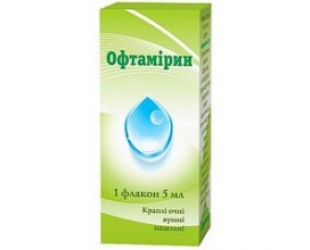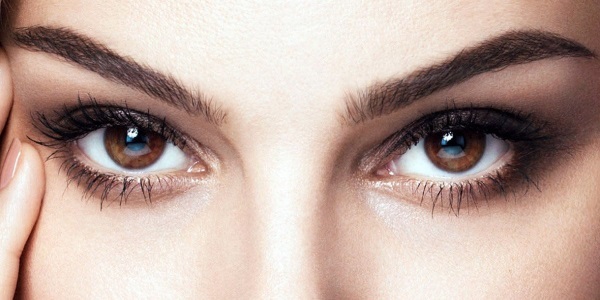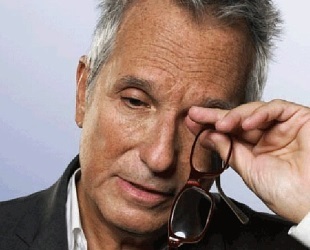
Eyes are very sensitive organs of the human visual system, which can be susceptible to various diseases and abnormalities.
Every ophthalmologist often has to face the fact that his patients complain about infectious diseases of the organs of vision.
For the fight against such diseases, the most commonly used drugs are in the form of drops.
These include Opharymine drops, since they have an antiseptic effect. In this article we will tell you about them in detail, we will analyze useful properties, indications for use, dosage, side effects and much more.
At the end of the article, you can find reviews of people who have already used the drops and decided to share their opinions.
- 1. Instructions for use
- 2. Side effects and contraindications
- 3. Terms and storage terms
- 4. Price
- 5. Analogues
- 6. Reviews
- 7. Conclusion
- 8. Useful video
Instruction foruse
Pharmacological action
The described drug has a direct effect on the pathogenic microflora, suppressing its vital functions and causing the death of microorganisms. Due to the good selectivity of the medicine, it does not pose any threat to the cells of the human body.
For Oftaminum a wide spectrum of action is characteristic. Its main active ingredient is miramistin , which has an immunomodulatory and anti-inflammatory effect. The peculiarity is that it exerts only local influence and does not enter the blood.
Opharymine promotes the strengthening of local defense reactions and recovery processes, as well as the activation of non-specific defense mechanisms, which causes the acceleration of regeneration.
Indications for use

Opharymine is used for:
- Infectious processes in the anterior part of the optic organ( keratitis, blepharitis, conjunctivitis, keratouveitis) caused by miramistin-susceptible organisms.
- Damage to the organs of vision.
- Temperature and chemical damage to organs of vision.
- To prevent gonococcal and chlamydial ophthalmia of newborns
- For the prevention and therapy of purulent-inflammatory diseases of the visual organs before the surgical intervention, and at the end of it.
Method of application of
In order to get rid of inflammatory and viral eye diseases, patients aged from 12 years of receive two to three drops of the described medicine in a bag of conjunctiva four to six times a day. For patients up to twelve years of age, the dose should be reduced to one or two drops. The duration of the treatment course is about two weeks.
If a surgical intervention of is required in the field of vision, two to three drops of ophthalmic are administered to him two or three days before the event, in three divided doses during the day. After the intervention, the drug is administered one to two drops three times a day for three to five days.
In case of eye burn Opharymine can be dripped only after thorough washing of the eye with water. The administration of this medication is carried out every five to ten minutes for two hours. After that, Ophamirin is prescribed to adults two to three drops, and persons up to twelve years of one to two drops, and dig in from four to six times during the day.
To prevent the development of ophthalmia in the born children , immediately after the birth of the baby, one drop of Opharymine is dripped into one and the second eye three times, with a gap of three minutes. This procedure should be carried out exclusively by medical personnel.

If the drops are stored in the refrigerator, the bottle must be warmed to the body temperature before use. Burying eyes Ophamirin is permitted in both lying and sitting position. To the drug has reached its goal, when it is introduced, it is necessary to gently pull the lower eyelid with your fingers.
After this, the patient should tilt his head back and direct his sight upward to prevent spontaneous closure of the eyelids. After dripping the eye, let go of the eyelid, but do not squint, as the drops may leak. You can lightly press your finger on the inner corner of the eye, pressing it to the nose.
During Opharymine use, care should be taken to ensure that the tip of the vial does not touch the organs of vision.
Form release, composition
Opharymine is produced in the form of colorless transparent drops, which are sold in bottles of 5 milliliters, placed in cardboard packaging. The producer of these drops is the Ukrainian company Darnitsa.
One milliliter of the drug contains:
- 0.1 milligram miramistine;
- sodium dihydrogen phosphate dihydrate;
- phosphate dodecahydrate;
- sodium chloride;
- sterile water;
Do you think you have conjunctivitis? This picture will help to clarify the nature of its origin:

Interaction with other drugs
When using Opharymine in combination with antibiotic agents of both local and systemic effects, the effect of this medication is increased. To consume alcoholic beverages during the entire period of therapy Ophmarin is strongly discouraged.
Side effects and contraindications

The only side effect of the described medication is a slight eye strain, which is observed immediately after the administration of drops.
It usually goes by itself within twenty seconds and is not an excuse for not using Opharymine.
Ophthalin does not affect the ability of the patient to drive vehicles and work with complex mechanisms, as well as other activities that require increased concentration.
Overdose
As of today, no cases of overdose with described drops have been reported in medicine, but exceeding the recommended dosage is highly undesirable.
Contraindications
Use of Ophthalin is not recommended for patients who have an increased susceptibility to at least one of the components of this drug.
During pregnancy
The period of bearing is not a contraindication to the use of Opharymine drops.
Storage conditions and storage times
The medicine described should be stored in its original packaging at a temperature of up to 30 degrees Celsius in a place inaccessible to children. In the period between the instillation procedures, the vial with droplets should be carefully twisted. After first use, Opharymine can be used only for twenty-eight days.
Price
Average price in Russia
The approximate cost of the described drug in Russian pharmacies currently amounts to 72 rubles .
Average cost in Ukraine
Residents of Ukraine wishing to purchase Ophthalin, will have to pay for this drug about 27 hryvnia .
Analogues
If necessary, drops of Ophthalin can be replaced with a drug of a similar effect. These drugs include the following drugs:
| Name | Short description |
| Okomistin | Operates on the basis of myramistin, costs 150 rubles and 55 hryvnia |
| Floxal | Is a solution of ofloxacin. Its price is 200 rubles and 120 hryvnia |
| Miramistin | The purchase will cost you 75 hryvnia or 230 rubles |
| Miramidez | The main active ingredient is Miramistin. Worth 42 hryvnia and 120 rubles |
| Linkomystin | The same miramistin. Its cost is 60 rubles and 218 hryvnia |
Reviews
Ophthalin can boast a huge number of positive reviews. The main advantages of these drops are the patients' almost complete absence of side effects and contraindications, ease of use and high efficiency. They argue that the symptoms of infectious eye damage disappeared without a trace after a couple of days of using Ophamirin.
At the end of this article, you can see more detailed reviews left by people who have had to use Ophthalin. But if you have ever been prescribed this drug, please share your opinion about Ophthyrin with other readers.
Conclusion

- Ophthalin is a drug that has an antiseptic and anti-inflammatory effect and helps accelerate the regeneration process.
- The active substance of ophthalmic is myramistin.
- The activity of this drug is manifested in such microorganisms as chlamydia, trichomonads, various fungi, herpes virus and dermatophytes, gram-positive and gram-negative microorganisms, as well as various hospital strains resistant to antibiotics.
- In ophthalmic practice, Ophthalin is prescribed for the treatment of various bacterial ailments, inflammation and trauma to the organs of vision, during the period before surgery and after it, and also to prevent the ophthalmia of newborns.
- This drug has virtually no contraindications and does not cause adverse reactions.
- It has an affordable cost and is recognized by patients.
- In pharmaceuticals, there are a number of drugs that, if necessary, you can replace Ophamirin.
